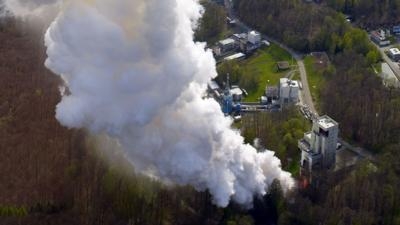Vulcain 2.1 Will Power The Ariane 6 Into Space In 2020
The new Vulcain 2.1 engine, which is set to carry the new European launcher Ariane 6 into space in 2020, is intended to achieve greater efficiency at lower costs. However, before such a launch can be successfully carried out, the development engines must prove that they can cope with the enormous 130-ton thrust, temperatures of approximately 3000 degrees Celsius in the combustion chamber, the high rotational speeds of the turbo pumps and the pressure in the propellant lines. On January 22, 2018, engineers at the German Aerospace Center (Deutsches Zentrum für Luft- und Raumfahrt; DLR) carried out a first successful test of the engine, developed by the ArianeGroup, on test stand P5 at Lampoldshausen. "We can evaluate the functional capability of the engine for the main stage only by constantly carrying out tests, in which we gradually take steps towards its ultimate use in space," explains Stefan Schlechtriem, Director of the DLR Institute of Space Propulsion. A total of 12 firings are planned for
the first test campaign at DLR.

Its predecessor, the Vulcain 2 main stage engine, is currently used on the Ariane 5 launcher and has so far completed 70 successful flights in a row. To create a more cost-effective and efficient generation of engines, Vulcain 2 is being redeveloped into the new Vulcain 2.1 engine, featuring a 3D-printed gas generator, a redesigned, simplified nozzle and a combustion chamber that can be ignited by the launcher's ground support system. Vulcain 2.1 will play a key role in carrying Ariane 6 up to an altitude of 150 kilometres (11 miles) within the first 10 minutes of flight. The DLR test on the Vulcain 2.1 main stage engine lasted 11 minutes, roughly a third longer than the engine would need to carry the Ariane 6 launcher up into space, assisted by solid-propellant boosters.
The decision to develop a new launcher system was taken in December 2014, when the member states of the ESA held their Council Meeting at Ministerial Level. They decided to opt for an enhancement of the existing generation of Ariane launchers in order to adapt to growing competition and heightened expectations on the world market. The new launcher was to build upon the existing components of Ariane 5. Depending on the configuration, Ariane 6 will be able to transport a payload of up to 11 tons into space, halving the cost of launches compared to Ariane 5. The new re-ignitable Vinci engine for the upper stage of Ariane 6 has been one of the elements tested at the DLR site in Lampoldshausen since 2005, and now the test runs for the new Vulcain 2.1 main stage engine have been added to the site's portfolio.
The aim of the seven-month test campaign is to gain a thorough understanding of all key features that distinguish the new main stage engine for the Ariane 6 launcher. "Only those who are fully familiar with these features can adjust the delicate combination of mechanical and electronic components, and thus get the engine to a stage where it is technically mature," stresses Schlechtriem. The first test was based on the Vulcain 2 engine, which has already been developed and is used in the current Ariane model. In this case, all of the pyrotechnical igniters were retained in order to compare the new engine with the older version. For the next test run, the combustion chamber will be ignited from the test stand using propane gas. At the end of the test campaign, the engine will have to successfully complete a final rehearsal on the DLR test stand in its definitive flight configuration.
"Testing is not just about seeing how this technology fares under normal operating conditions. We want to look at how it copes with stresses that go beyond those normally experienced in flight – in other words, at higher temperatures, at high and low combustion chamber pressures and with different fuel mixture ratios," says Anja Frank, Head of the Department of Test Facilities at DLR Lampoldshausen. "We are using the development engine to assess the limits of the Vulcain 2.1."
The results of the tests carried out by engineers, technicians and test stand workers at the DLR Institute of Space Propulsion will not only be proof of the engine’s functional capabilities, but also a source of a large amount of data. Ultimately, the use of a high-precision measuring and analysis system makes it possible to obtain accurate results and thus allows the ArianeGroup engine developers to draw detailed conclusions about technical issues. The final design of the main stage engine requires a thorough understanding of the pressures and temperatures in the propellant lines, the rotational speeds of the turbo pumps, the pressures in the gas generator and combustion chamber, and the resulting vibrations to which the engine is subjected during a hot run.
(Image provided with German Aerospace Center news release)
 NTSB Prelim: Funk B85C
NTSB Prelim: Funk B85C Aero-News: Quote of the Day (11.21.25)
Aero-News: Quote of the Day (11.21.25) ANN's Daily Aero-Term (11.21.25): Radar Required
ANN's Daily Aero-Term (11.21.25): Radar Required Classic Aero-TV: ScaleBirds Seeks P-36 Replica Beta Builders
Classic Aero-TV: ScaleBirds Seeks P-36 Replica Beta Builders Airborne 11.21.25: NTSB on UPS Accident, Shutdown Protections, Enstrom Update
Airborne 11.21.25: NTSB on UPS Accident, Shutdown Protections, Enstrom Update



